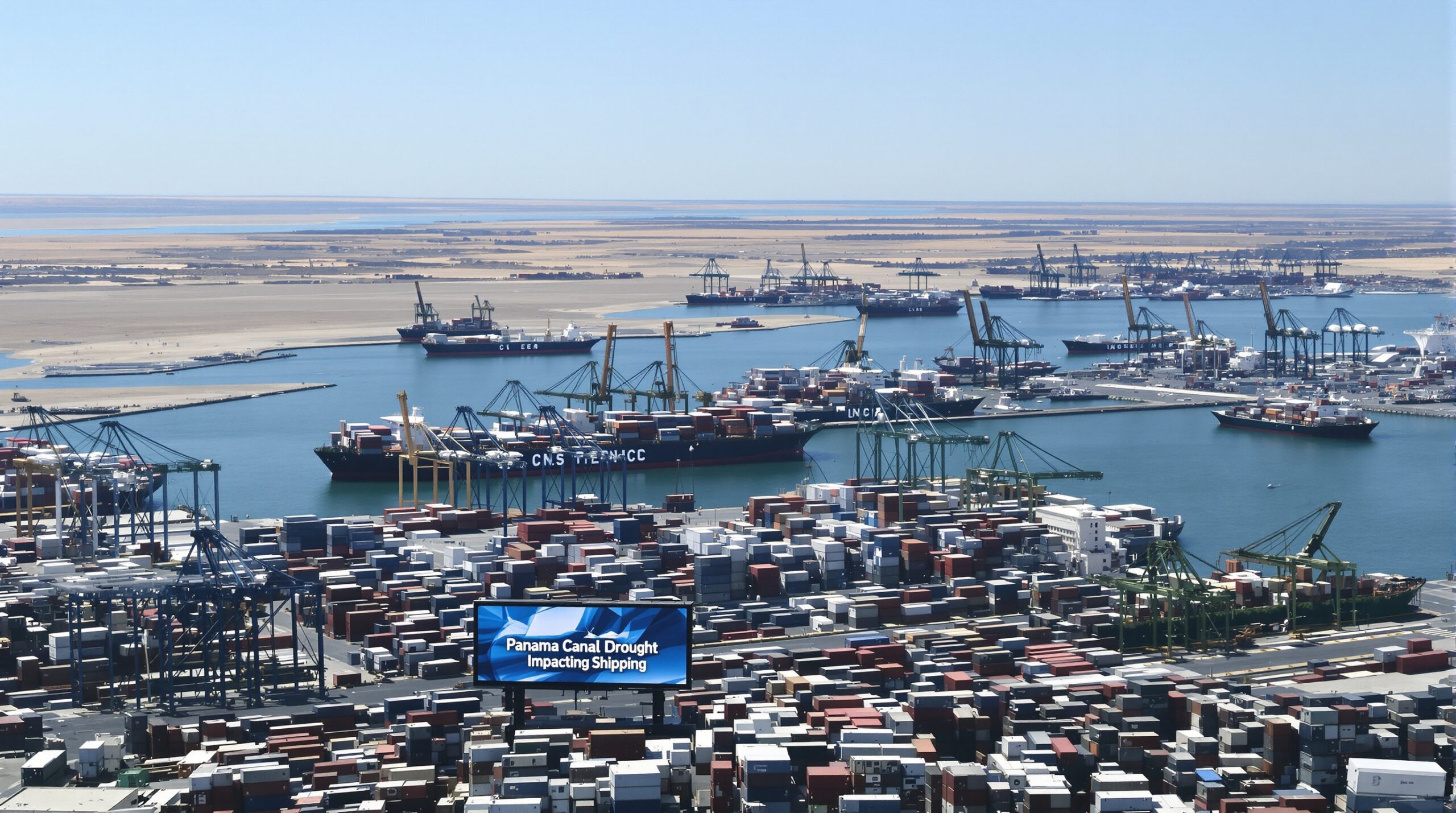The Panama Canal is a crucial artery for global trade, linking the Atlantic and Pacific Oceans. However, unprecedented drought conditions have dramatically slowed shipping through this passage. As a result, ports around the world are experiencing significant backlogs. This disruption impacts supply chains, raises costs, and challenges global commerce in new ways.
The Importance of the Panama Canal in Global Shipping
Each year, over 14,000 ships pass through the Panama Canal, carrying more than 330 million tons of cargo. The canal shortens the journey between the Atlantic and Pacific Oceans by almost 8,000 miles. Container ships, oil tankers, and bulk carriers depend on this route for efficiency. Any disruption reverberates across global supply chains and affects industries worldwide.
Drought Conditions Reduce Canal Capacity
This year, Panama experienced its lowest rainfall in decades, causing a severe drought. The canal depends on freshwater from nearby lakes to operate its lock system. Diminished rainfall has lowered water levels in these lakes below operational thresholds. Consequently, canal authorities have imposed vessel draft restrictions and reduced daily ship transits from an average of 36 to as few as 22.
Lower water levels mean ships must carry less cargo to safely clear the locks. Restrictions not only delay individual shipments but also reduce the overall throughput of global cargo. The world’s busiest shipping lanes now face bottlenecks greater than at any time in the past decade.
Port Backlogs Ripple Across the Globe
Backlogs at the Panama Canal quickly transmit down the line to ports in North America, Europe, and Asia. Ships that fail to secure a transit slot often wait for more than a week. Some carriers have chosen alternative, longer routes through the Suez Canal or around Cape Horn. These choices increase fuel costs, travel times, and congestion at other major ports.
Major U.S. East Coast ports such as Savannah, Charleston, and New York are experiencing increased congestion. Not only do more vessels arrive at once, but schedule unpredictability is rising too. Truck and rail operations at these ports also feel the strain, as backlogs disrupt the onward movement of goods. The situation is similar at European entry points, with Hamburg and Rotterdam feeling the pressure.
Economic Impacts on Global Trade
Shipping delays contribute directly to higher prices for consumers and businesses alike. Freight rates for routes that traverse the canal have increased by as much as 20 percent. Supply chain uncertainties create shortages or overstock at destinations, especially for time-sensitive goods. Commodity shipments of grain and energy products are particularly affected, as tight schedules must be maintained to prevent spoilage or market disruptions.
Industries relying on “just-in-time” inventory suffer the most. Automobile manufacturers, electronics producers, and retail chains face acute logistical challenges. As a result, production schedules get interrupted, and some companies may seek to renegotiate contracts or find new suppliers. The ripples from canal delays reach far beyond the shipping industry itself.
Shipping Companies Adapt to the Crisis
Shipping companies have responded by exploring alternative routes for their fleets. Some are sending vessels through the Suez Canal, despite the longer journey. Others detour around the southern tip of South America. Both options mean added days or even weeks to transit times, with increased fuel consumption and environmental impact.
Some carriers now consolidate shipments, combining loads onto fewer, larger vessels that can still pass through the Panama Canal with reduced draft. This strategy can maximize each transit, but scheduling becomes more difficult. More shipping lines are also investing in digital solutions for real-time cargo tracking and rerouting. Greater transparency can help inform customers about delays, but the underlying capacity limits persist.
Long-Term Environmental and Operational Concerns
Experts warn that climate change could make Panama Canal droughts more frequent and severe in the coming years. The canal’s lakes, its main water sources, are sensitive to shifts in precipitation. Authorities in Panama have launched projects to find alternative water supplies to keep the canal operating at full capacity. These efforts include investments in water reservoirs and enhanced conservation.
Sustained droughts may force shippers, manufacturers, and governments to rethink core assumptions about global trade efficiency. Greater regionalization or more inventory storage closer to the market may help. Continued innovation will be essential to adapt to new disruptions. The economic stakes for Panama, which relies on canal tolls for a significant portion of its GDP, are also very high.
Future Prospects and Steps Toward Solutions
Port authorities and shipping companies are developing lessons learned during this crisis. Investments in digital infrastructure enhance visibility and coordination across global supply chains. Many shippers are now reviewing their risk management strategies and contingency plans. Logistics providers are diversifying routes and putting more resources into predictive analytics.
The Panama Canal Authority is fast-tracking projects to boost resilience. Dredging operations are underway to maximize available depth in crucial sections. At the same time, international organizations provide technical and financial support to Panama’s water management initiatives. While drought-related delays remain, such efforts may help restore some confidence for the world’s shippers.
Conclusion: Addressing Systemic Vulnerabilities in Global Logistics
The Panama Canal drought has highlighted how intertwined global logistics networks truly are. When one crucial point faces adversity, the ripple effects overwhelm ports worldwide. Stakeholders must now collaborate on both immediate solutions and long-term investments. The ultimate goal is to ensure that world trade can withstand the shocks of an uncertain future. As climate change-driven events become more common, adaptability and foresight will shape the resilience of international shipping and trade.

